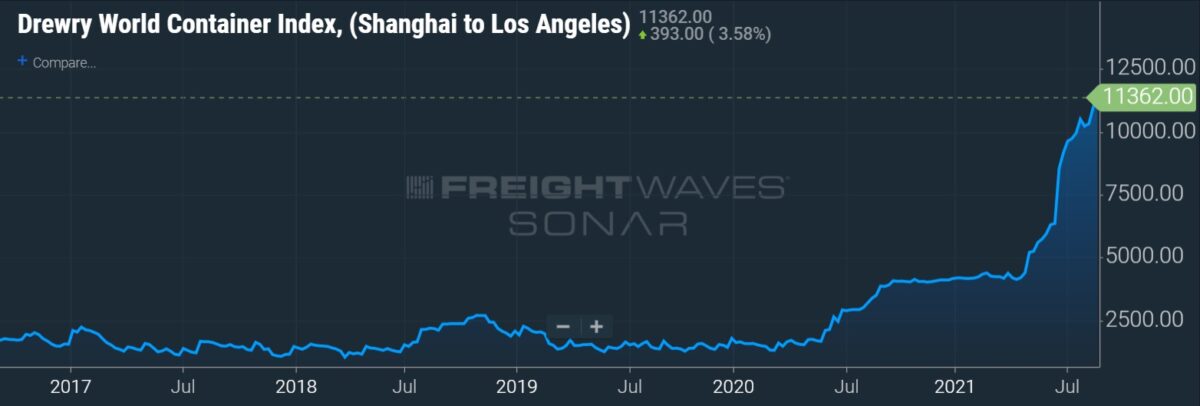Discount chain Dollar Tree reeled in its outlook for fiscal 2021, citing escalating freight costs as the reason. The Chesapeake, Virginia-based retailer said it has started to book its own ocean vessels amid a tight capacity environment and will look for merchandise suppliers outside of Asia to mitigate transportation expenses going forward.
“We’re optimizing which China and U.S. ports we use to take advantage of the shipping availability,” Michael Witynski, president and CEO, told analysts on a Thursday conference call. “We are confident that our teams will allow us to navigate through this period of global supply chain challenges.”
Dollar Tree (NASDAQ: DLTR) said elevated transportation expenses will drag down full-year earnings by $1.50 to $1.60 per share compared to last year. The update assumes an additional freight spend of $185 million to $200 million (60 cents to 65 cents per share) above the prior forecast issued at the end of May.
The revised full-year EPS range of $5.40 to $5.60 is 7% lower (at the midpoint) than the quarter-ago guide and shy of the $5.65 recorded last year.
The change is due to the likelihood the company will be more dependent on the spot market for ocean shipping capacity going forward. At the end of its fiscal first quarter, the expectation was ocean carriers would honor approximately 85% of contractual commitments with Dollar Tree. That number is now likely to be closer to 60% to 65%.
Management said spot market rates have moved roughly 20% higher since the May update.

A multitude of capacity, equipment and labor shortages have the nation’s supply chain moving at a snail’s pace. Extremely tight ocean sailing schedules are being pushed out further given growing delays finding berths at U.S. ports. Boxes are also being turned slower given increased dwell time at container terminals, slow rail service and labor headwinds at inland warehouses.
Dollar Tree recently chartered dedicated space on container ships for the first time. It entered a three-year contract for “one large vessel,” which is expected to make its first voyage for the company in the next few weeks. Management said the company will continue to add more ocean charters this year and will continue seeking new suppliers domestically as well as in other regions to minimize its exposure to the trans-Pacific trade lane.
“Dollar Tree and Family Dollar were well prepared for back-to-school season with alternatively sourced domestic product,” said Witynski. “We’re taking a fresh look at which SKU should be prioritized for import and which should be alternatively sourced [and] prioritizing containers based on seasonality, the margin impact and our overall inventory needs.”
As ocean shipping schedules continue to be extended, other retailers have been procuring container ship capacity on an exclusive basis as well. The Home Depot (NYSE: HD) and Walmart (NYSE: WMT) recently announced they have entered charter agreements for vessels to move only their product in the back half of 2021.
Dollar Tree actually posted better-than-expected results in the quarter ended July 31. Earnings per share of $1.23 came in 22 cents ahead of consensus, but shares tanked on the warning that freight costs and general cost inflation are likely to linger longer.
The stock gapped down 14.5% in the two trading sessions that followed the report, compared to the S&P 500, which was up 0.3%.
“The Dollar Tree banner is more sensitive to freight costs than others in the industry,” Witynski said. “Our products have lower price points than other retail importers. And, as a result, our freight costs are a higher percentage of our gross merchandise margin.”
Gross margin came in at 29.4% in the quarter, 110 basis points lower year-over-year. Merchandise costs (+175 bps), notably higher freight costs, were the culprits.
Dollar Tree is a top-5 U.S. importer, bringing in approximately 90,000 forty-foot equivalent units annually. If freight costs were level with last year, management said EPS would likely be in the range of $6.90 to $7.20 this year, well above the $5.50 it has guided to.
“The supply chain issues, which we are confident are transitory in nature, will take some time until the global demand and supply for equipment is rebalanced,” Witynski continued. “Importantly, we believe the foundation of our business is stronger than ever. We believe we are in the process of materially improving the long-term earnings power of our business for years to come.”












Anna
I am now making more than 350 dollars per day by working online from home without investing any money.
Join this link posting job now and start earning without investing or selling anything.
visit here………… www.jobs70.com
Stephen Webster
We need a range of minimum wage rates and minimum and maximum freight rates range for truck air and sea rates for a minimum of 3 years. The current events are not in our best interest as a country. A truck driver based protest is going to happen in certain parts of the world. Homeless shelters are home for too many essential workers in Ontario Canada.